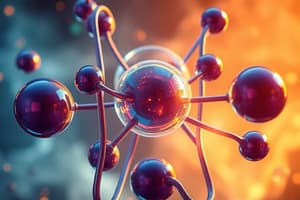Podcast
Questions and Answers
What are the three primary subatomic particles that make up an atom?
What are the three primary subatomic particles that make up an atom?
- Electrons, isotopes, and protons
- Protons, neutrons, and electrons (correct)
- Protons, isotopes, and electrons
- Neutrons, electrons, and ions
Where are protons and neutrons located within an atom?
Where are protons and neutrons located within an atom?
- In the nucleus (correct)
- In the electron cloud
- In the orbitals
- In the energy levels
What is the charge of protons, and what is the charge of neutrons?
What is the charge of protons, and what is the charge of neutrons?
- Protons are negatively charged, neutrons are positively charged
- Protons and neutrons both carry a positive charge
- Protons are neutrally charged, neutrons are negatively charged
- Protons are positively charged, neutrons are neutrally charged (correct)
Where do electrons orbit within an atom?
Where do electrons orbit within an atom?
What provides the mass of an atom, and what plays a crucial role in determining chemical behavior?
What provides the mass of an atom, and what plays a crucial role in determining chemical behavior?
Study Notes
Atomic Structure
- The three primary subatomic particles that make up an atom are protons, neutrons, and electrons.
Protons and Neutrons
- Protons and neutrons are located in the nucleus of an atom.
- Protons have a positive charge, while neutrons have no charge (neutral).
Electron Orbit
- Electrons orbit outside the nucleus in energy levels or electron shells.
Atomic Mass and Chemical Behavior
- The mass of an atom comes mainly from the protons and neutrons in the nucleus.
- The number of protons in an atom (atomic number) plays a crucial role in determining chemical behavior.
Studying That Suits You
Use AI to generate personalized quizzes and flashcards to suit your learning preferences.
Description
Explore the world of atoms and molecules in this captivating quiz. Delve into their structures, properties, interactions, and significance in chemistry and beyond. Unveil the essence of matter and enhance your understanding of the fundamental building blocks of the physical world.




